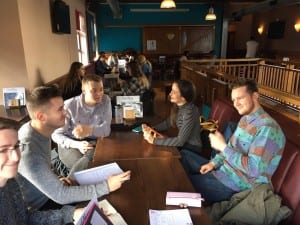Friday 21st October
Planning Ahead
After the tutorial meeting with David, the Sound Team met up to discuss next week’s work. First of all, after the meeting on Tuesday we discussed research that Hannah had set us. Unfortunately, some was slightly irrelevant to us which was no fault of Hannah’s, instead we suggested the research we would do and tailor her suggestions to this (Hannah’s set research were starting-blocks anyway). Therefore, we agreed for Rob to continue his Location Sound research as he has done the most at this stage in time, focussing primarily on boom techniques to start with. Dan agreed to take Microphones. Which mics we will choose to use and why. Finally, I am to look at Lauren’s director notes on sound and use research on film sound to suggest creative ways to use music, and certain license free music that we could use.
Succeeding this, we organised when we would work on what project the following week. As it stands, Rob, Dan and myself are working on three films in Semester A. This includes Location and Post for Cognition, Post for Agriculture, a film made by our editor Tom over the Summer, and Callback, a film directed by Molly Naylor. Matt North got in touch with David for help on this and we agreed to support him. For this project we are in charge of sourcing realistic ambience and atmos tracks, as well as providing the necessary Foley for the film.
Monday, Tuesday and Wednesday if necessary we have planned to work on Callback, as Matt has set several deadlines for us to follow. Thereafter, Wednesday, Thursday and Friday we shall continue work on Agroculture for Tom. Additionally, we assigned Agroculture roles:
Sam + Dan = Dialogue
Rob + whoever is not working on Dialogue that particular day = Foley + Foley Mix
whoever is not working on the Dialogue Mix = SFX + SFX Mix
Final Mix = Complete Team.
